Directional Bending Performance of 4-Leg Jacket Substructure Supporting a 3MW Offshore Wind Turbine
Abstract
1. Introduction
- Assessment of structural responses of a 4-leg jacket substructure under extreme environmental loads (i.e., wind, wave, and current loading conditions);
- Determination of critical bending direction of the 4-leg jacket substructure under various loading conditions;
- Calculation of percentage contribution of the environmental load effects to the total structural response of the 4-leg jacket substructure supporting an OWT.
2. 3 MW 4-Leg Jacket Substructure Model
2.1. Configuration of the 4-Leg Jacket Substructure
2.2. Environmental Conditions
3. Modeling of the Support Structure
3.1. Tower
3.2. Transition Piece (TP)
3.3. Jacket Structure
3.4. Material Properties
4. Parameters for the Study
4.1. Wave Parameters
4.2. Environmental Loading Directionality
4.3. Critical Responses and Critical Loading Angles
4.4. Design Check
- Under axial tension and bending
- Under axial compression and bendingin which, and are the design axial force, bending moments about y and z axes of the jacket members, respectively; and are design bending moment, axial tension, and compressive resistance, respectively; and are reduction factors about y and z axes, respectively, taken from Table 6-2 in Reference [21]; is the design axial local buckling resistance; and are Euler buckling strengths about y and z axes, respectively. Formulations of the forces, bending moment resistances, and Euler buckling strengths (i.e., and) can be found in Section 6.3 of the Reference [21].
4.5. Assumptions for the Numerical Analysis
5. Results of the Analysis
5.1. Modal Analysis
5.2. Structural Analysis
5.2.1. Structural Responses under Extreme Environmental Loads (Env Loads)
5.2.2. Structural Responses under DLC Loads
5.3. Structural Responses under Combined Loads (Env Loads + DLC Loads)
6. Conclusions and Observations
- Under Env loading conditions, the 4-leg jacket substructure shows maximum structural responses (i.e., maximum lateral displacements at the tower-substructure interface and maximum stresses at the lower jacket legs) at the loading angles of 135° and 315°. This indicates that the smallest bending stiffness can be found in one of the 4-leg jacket diagonal directions.
- From the study above, it is also found that the polar diagrams are very useful to present directional bending performances of the 4-leg jacket substructure.
- From the structural responses under 12 DLC loading conditions, relatively large lateral displacements and stresses are obtained in the cases of DLC2, DLC3, DLC4, DLC9, and DLC10. These five cases also showed similar results when the 12 DLC loads are combined with the 24 Env loading directions.
- Under CB loading conditions, critical angles for the bending of the 4-leg jacket substructure are found to be from 105° to 150°. In order to maximize the structural efficiency of the jacket substructure, it is recommended that this range of the jacket’s angle in the plane should be avoided from the condition of facing the critical design loads.
- Comparing to the total structural responses of the 4-leg jacket substructure, supporting a 3MW offshore wind turbine, it is found that the maximum Env load effects show a moderate contribution; the maximum percentage of 27.24% in the case of lateral displacements at the tower-substructure interface and the maximum percentage of 37.39% in the case of stresses at the lower jacket legs.
Author Contributions
Funding
Institutional Review Board Statement
Informed Consent Statement
Data Availability Statement
Conflicts of Interest
References
- Bhattacharya, S. Design of Foundations for Offshore Wind Turbines; Wiley: Hoboken, NJ, USA, 2019. [Google Scholar]
- Kim, D.H.; Lee, S.G. Reliability analysis of offshore wind turbine support structures under extreme ocean environmental loads. Renew. Energy 2015, 79, 161–166. [Google Scholar] [CrossRef]
- Shi, W.; Park, H.; Han, J.; Na, S.; Kim, C. A study on the effect of different modeling parameters on the dynamic response of a jacket-type offshore wind turbine in the Korean Southwest Sea. Renew. Energy 2013, 58, 50–59. [Google Scholar] [CrossRef]
- Shi, W.; Han, J.; Kim, C.; Lee, D.; Shin, H.; Park, H. Feasibility study of offshore wind turbine substructures for southwest offshore wind farm project in Korea. Renew. Energy 2015, 74, 406–413. [Google Scholar] [CrossRef]
- Kim, D.H.; Lee, S.G.; Lee, I.K. Seismic fragility analysis of 5MW offshore wind turbine. Renew. Energy 2014, 65, 250–256. [Google Scholar] [CrossRef]
- Chella, M.A.; Tørum, A.; Myrhaug, D. An overview of wave impact forces on offshore wind turbine substructures. Energy Procedia 2012, 20, 217–226. [Google Scholar] [CrossRef]
- Jeong, Y.-J.; Park, M.-S.; Kim, J.; Song, S.-H. Wave force characteristics of large-sized offshore ưind support structures to sea levels and wave conditions. Appl. Sci. 2019, 9, 1855. [Google Scholar] [CrossRef]
- Ko, K.; Kim, K.; Huh, J. Variations of wind speed in time on Jeju Island, Korea. Energy 2010, 35, 3381–3387. [Google Scholar] [CrossRef]
- Tran, T.-T.; Hussan, M.; Kim, D.; Nguyen, P.-C. Distributed plasticity approach for the nonlinear structural assessment of offshore wind turbine. Int. J. Nav. Archit. Ocean Eng. 2020, 12, 743–754. [Google Scholar] [CrossRef]
- Lyu, G.; Zhang, H.; Li, J. Effects of incident wind/wave directions on dynamic response of a SPAR-type floating offshore wind turbine system. Acta Mech. Sin. Xuebao 2019, 35, 954–963. [Google Scholar] [CrossRef]
- Kim, S.Y.; Kim, K.M.; Park, J.C.; Jeon, G.M.; Chun, H.H. Numerical simulation of wave and current interaction with a fixed offshore substructure. Int. J. Nav. Archit. Ocean Eng. 2016, 8, 188–197. [Google Scholar] [CrossRef]
- Lin, T.-Y.; Zhao, Y.-Q.; Huang, H.-H. Representative Environmental Condition for Fatigue Analysis of Offshore Jacket Substructure. Energies 2020, 13, 5494. [Google Scholar] [CrossRef]
- Zhang, J.; Kang, W.-H.; Sun, K.; Liu, F. Reliability-Based Serviceability Limit State Design of a Jacket Substructure for an Offshore Wind Turbine. Energies 2019, 12, 2751. [Google Scholar] [CrossRef]
- Chew, K.-H.; Eddie, Y.N.; Tai, K. Offshore Wind Turbine jacket substructure: A comparison study between four-legged and three-legged designs. J. Ocean Wind Energy 2014, 1, 74–81. [Google Scholar]
- Vorpahl, F.; Wojciech, P.; Daniel, K. Description of a basic model of the “UpWind reference jacket” for code comparison in the OC4 project under IEA Wind Annex 30. In Offshore Code Comparison Collaboration Continuation (OC4); National Renewable Energy Laboratory: Golden, CO, USA, 2013. [Google Scholar]
- POSCO. 4-Leg Jacket Substructure for 3MW Offshore Wind Turbine; Structural Design Report; POSCO: Pohang, Korea, 2017. [Google Scholar]
- Kim, J.Y.; Oh, K.Y.; Kang, K.S.; Lee, J.S. Site selection of offshore wind farms around the Korean Peninsula through economic evaluation. Renew. Energy 2013, 54, 189–195. [Google Scholar] [CrossRef]
- Structural Analysis Computer System (SACS), User’s Manual, Release 14, Version 0, Engineering Dynamics; Bentley: Chester County, PA, USA, 2019.
- DNVGL. DNVGL-DNV-OS-J101–Design of Offshore Wind Turbine Structures; DNVGL: Oslo, Norway, 2014. [Google Scholar]
- Tran, T.-T.; Kim, E.; Lee, J.; Lee, D. A study on dynamic response of 4-leg jacket structures under different Sea water levels. In Proceedings of the KWEA Fall Conference, Jeju, Korea, 13 November 2020. [Google Scholar]
- NORSOK. Norsok N-004 Standard-Design of Steel Structures; NORSOK: Oslo, Norway, 2004. [Google Scholar]
- Bossanyi, E. GH-Bladed Version 4.0 User Manual 2010; Garrad Hassan and Partners Limited: Bristol, UK, 2010. [Google Scholar]
- IEC. Wind Turbines-Part 1: Design Requirements; IEC: Geneva, Switzerland, 2005. [Google Scholar]
- DVNGL. DVNGL-ST-0437 Loads and Site Conditions for Wind Turbines; ISO: Geneva, Switzerland, 2016. [Google Scholar]
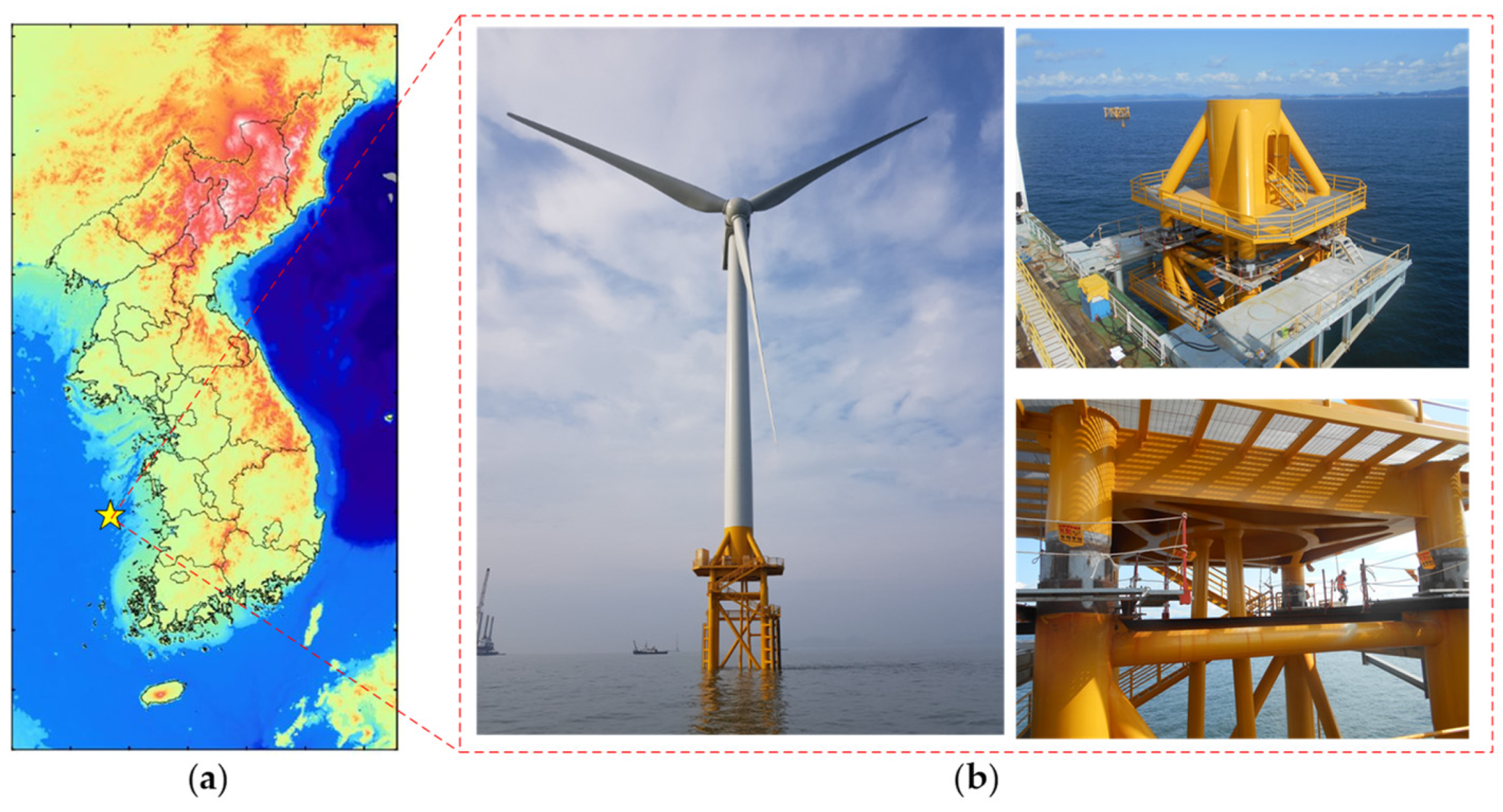
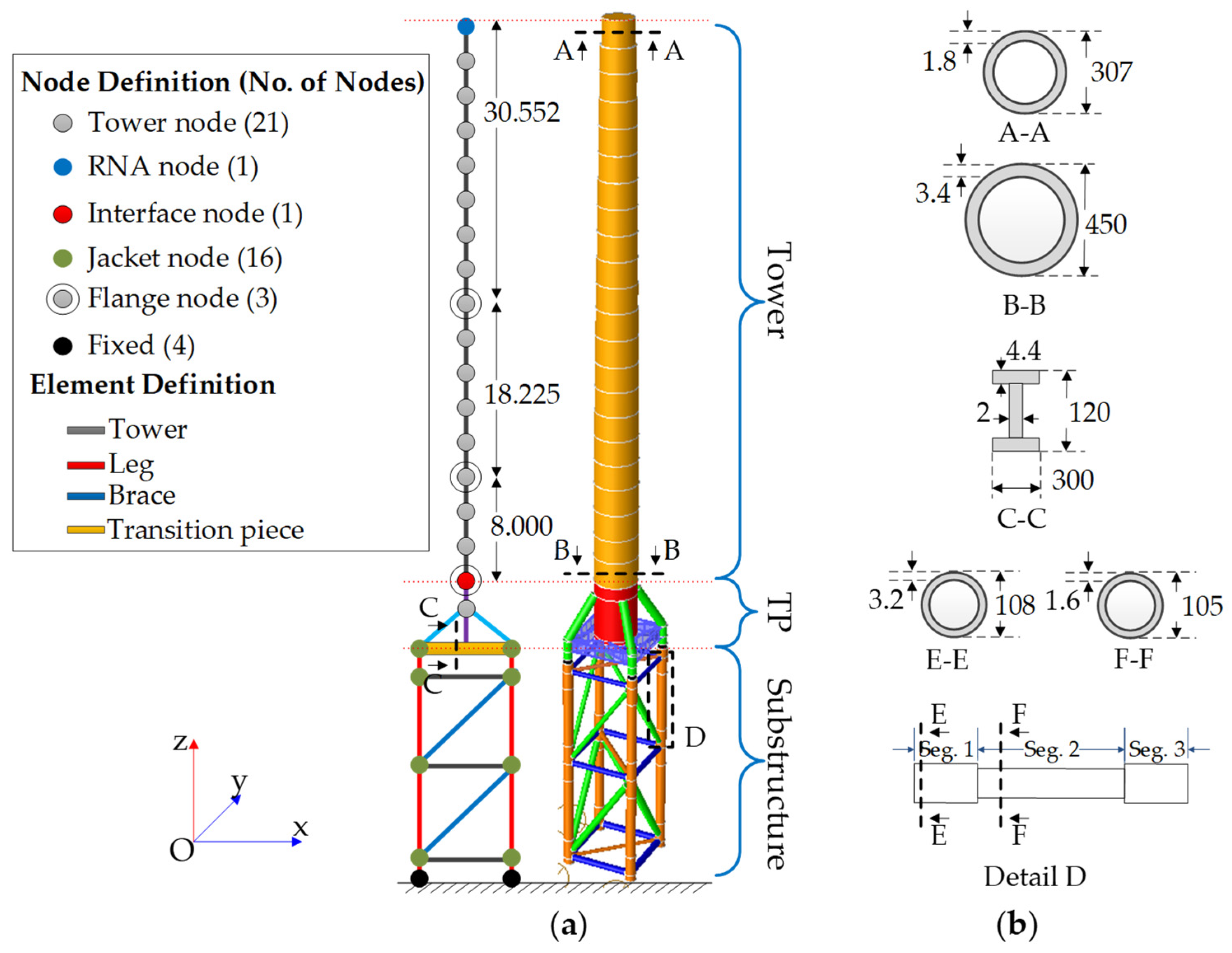
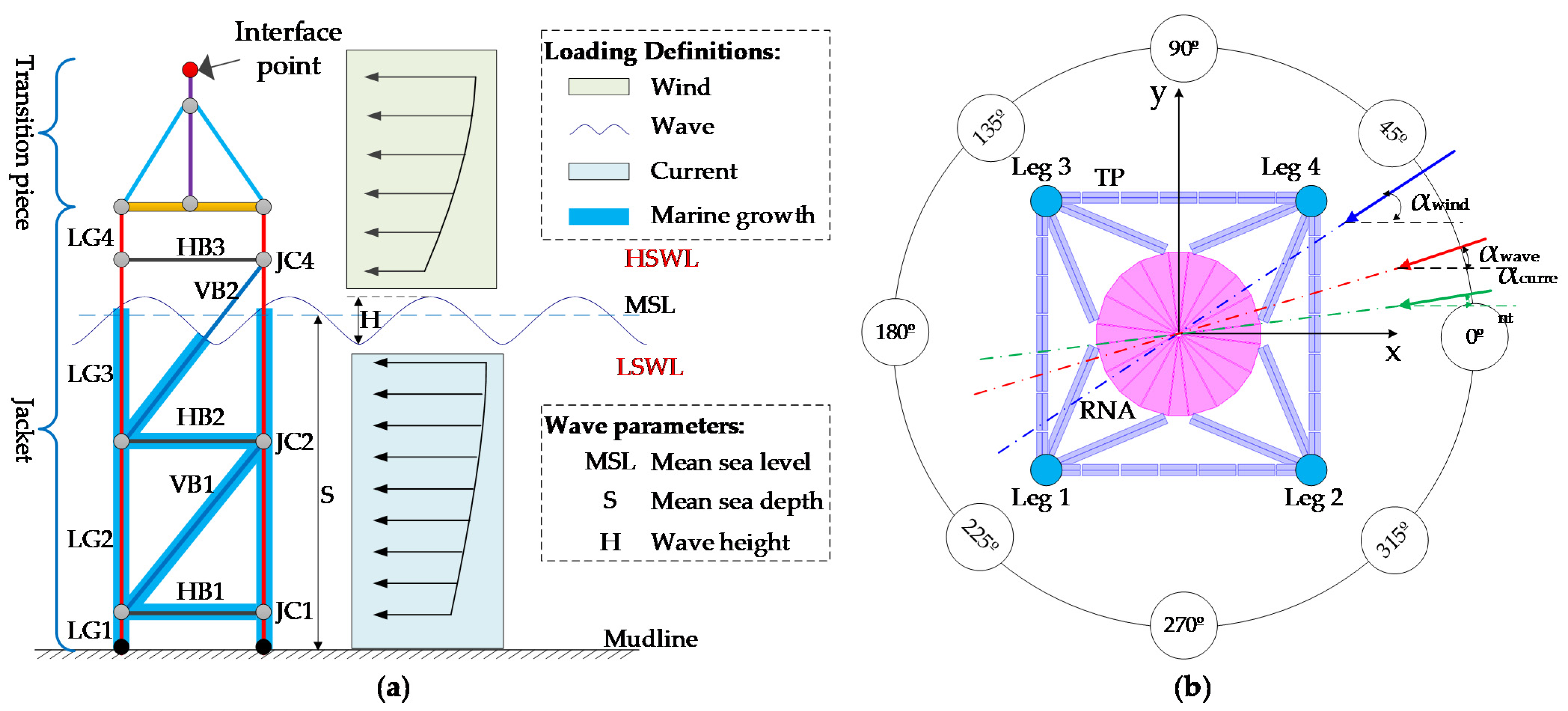
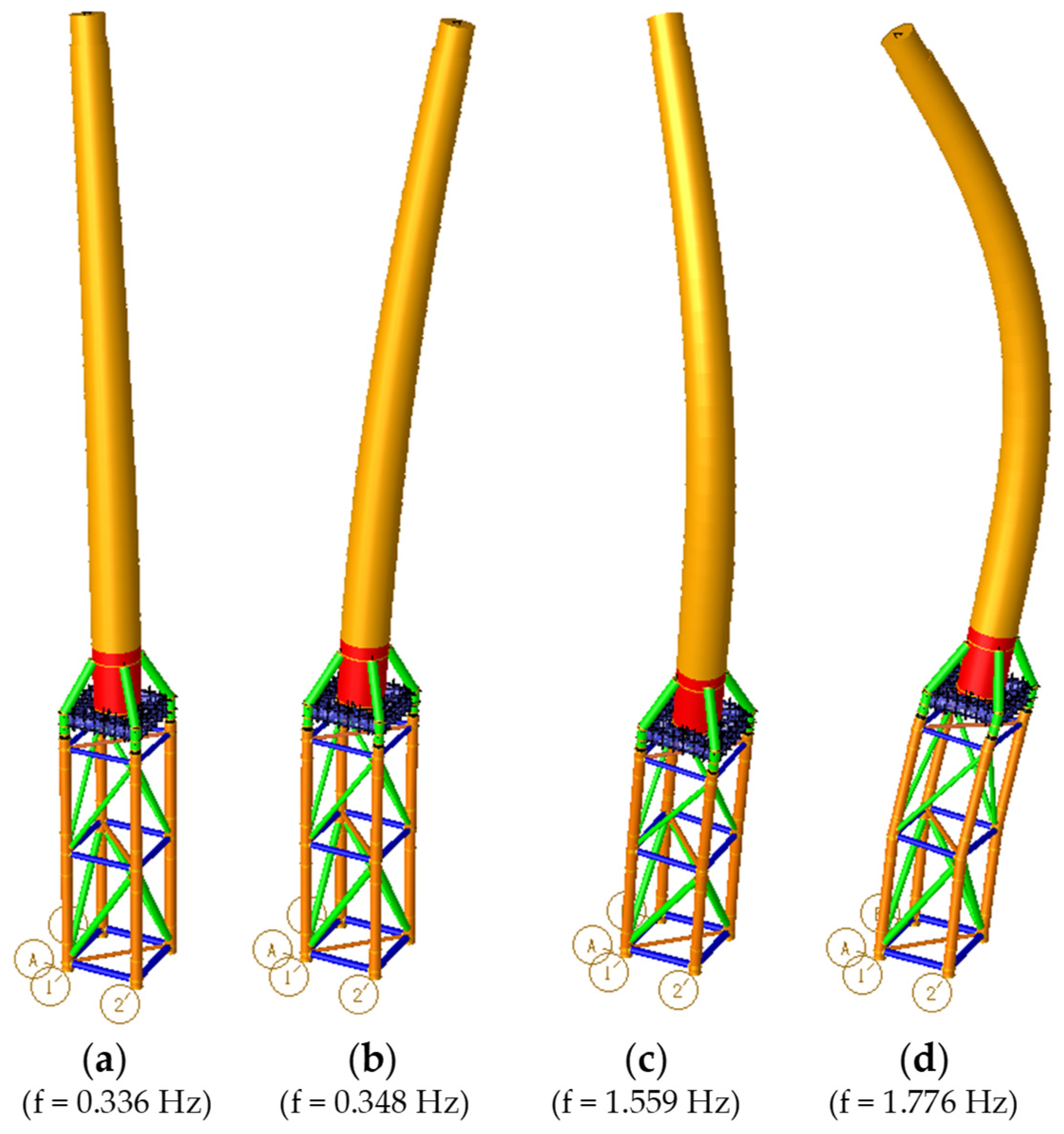

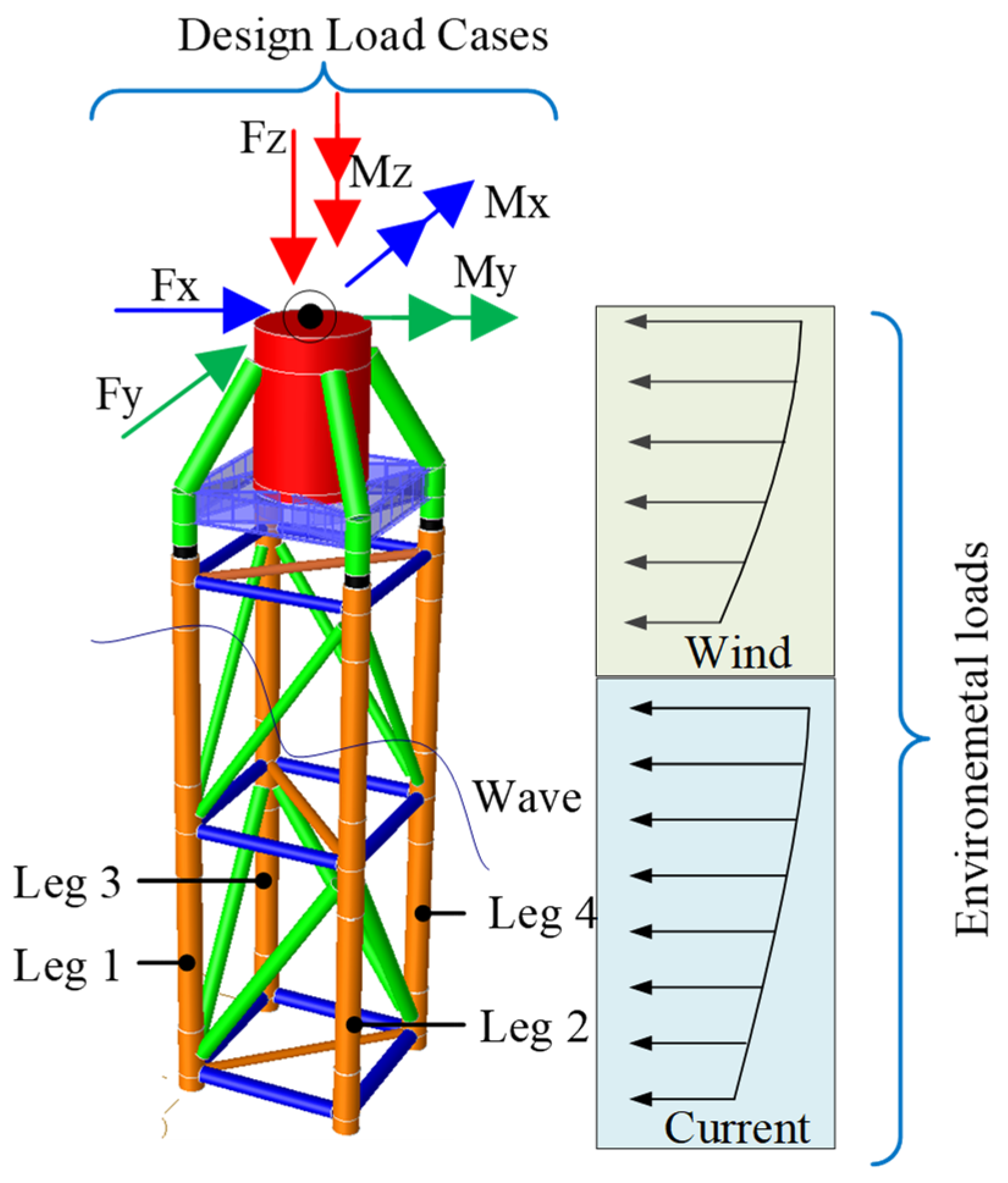
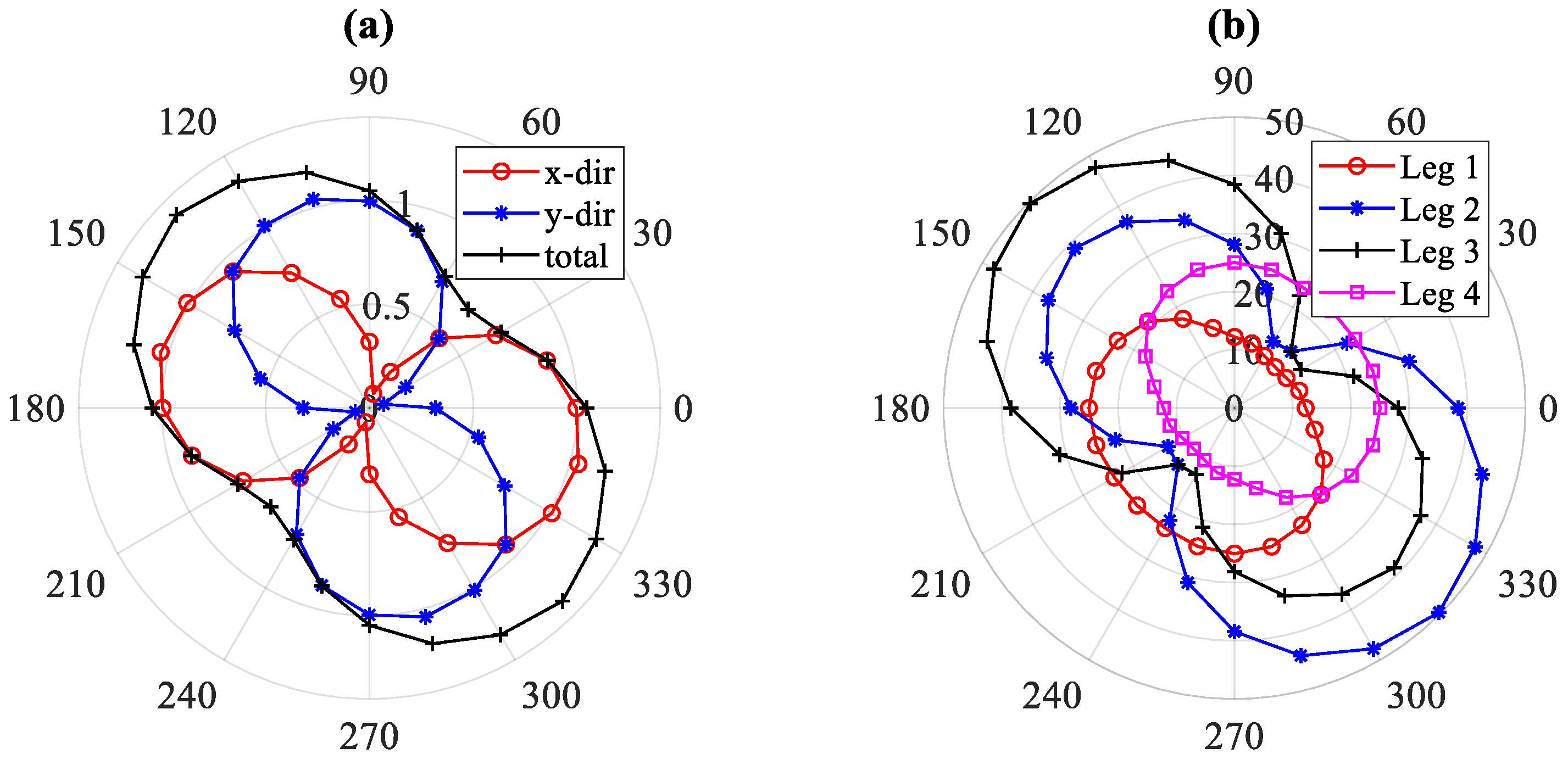
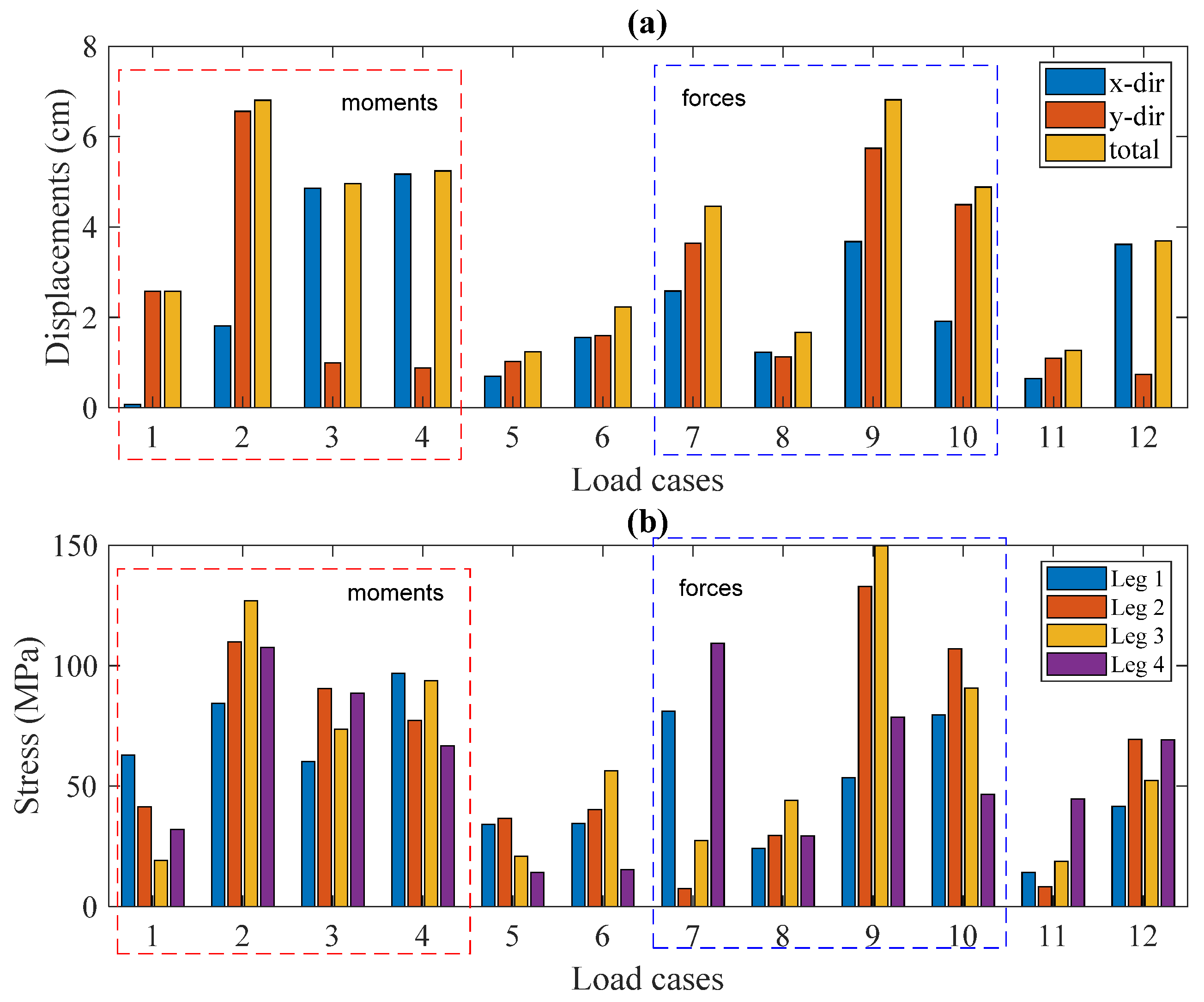
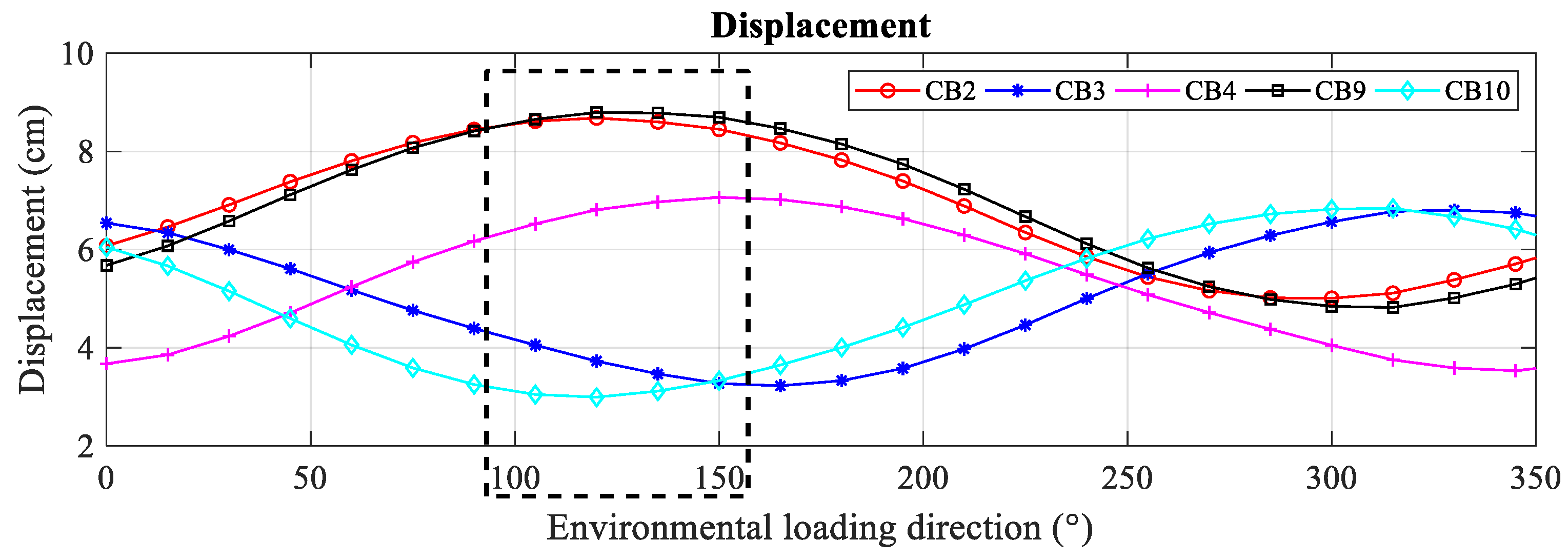
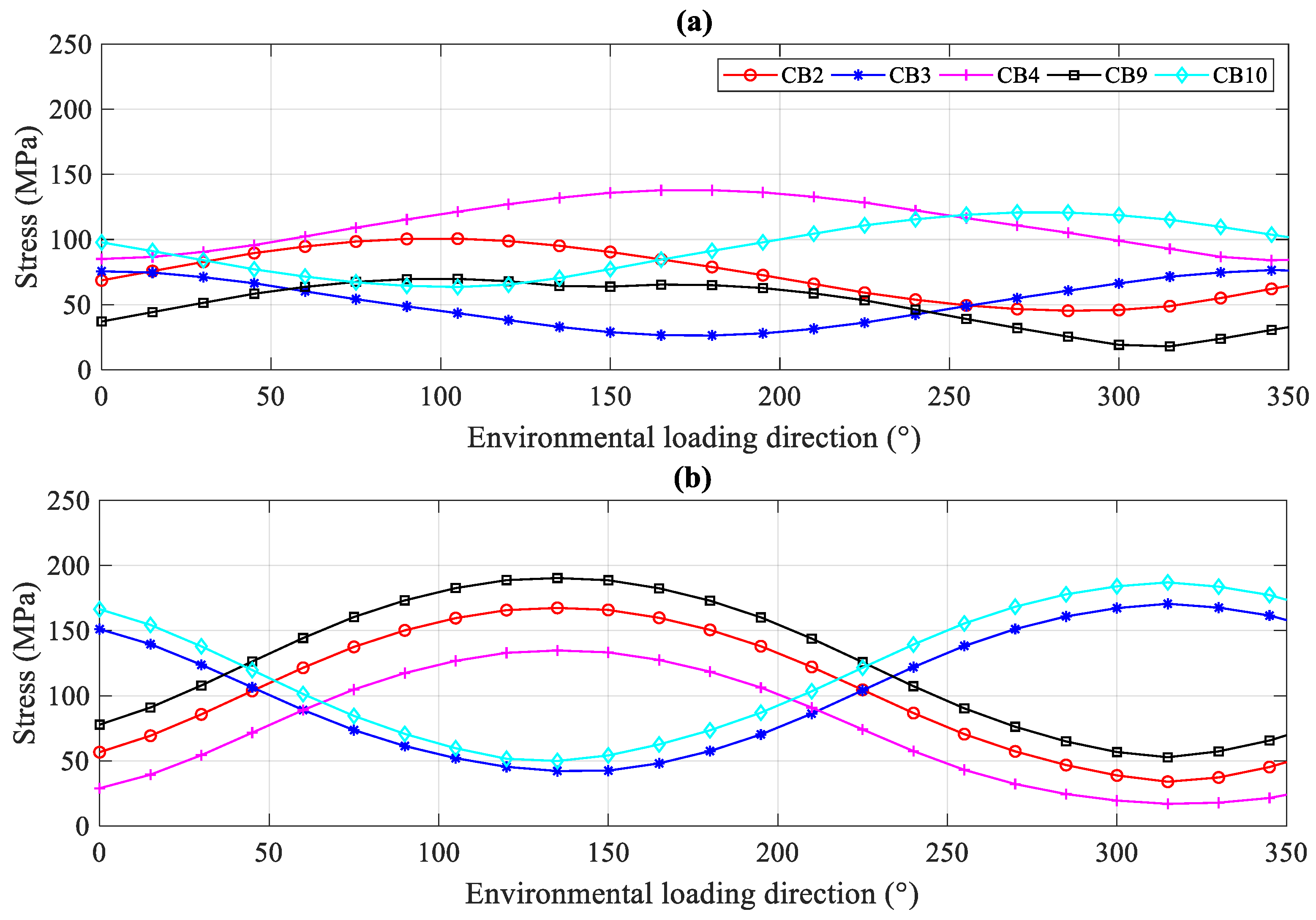
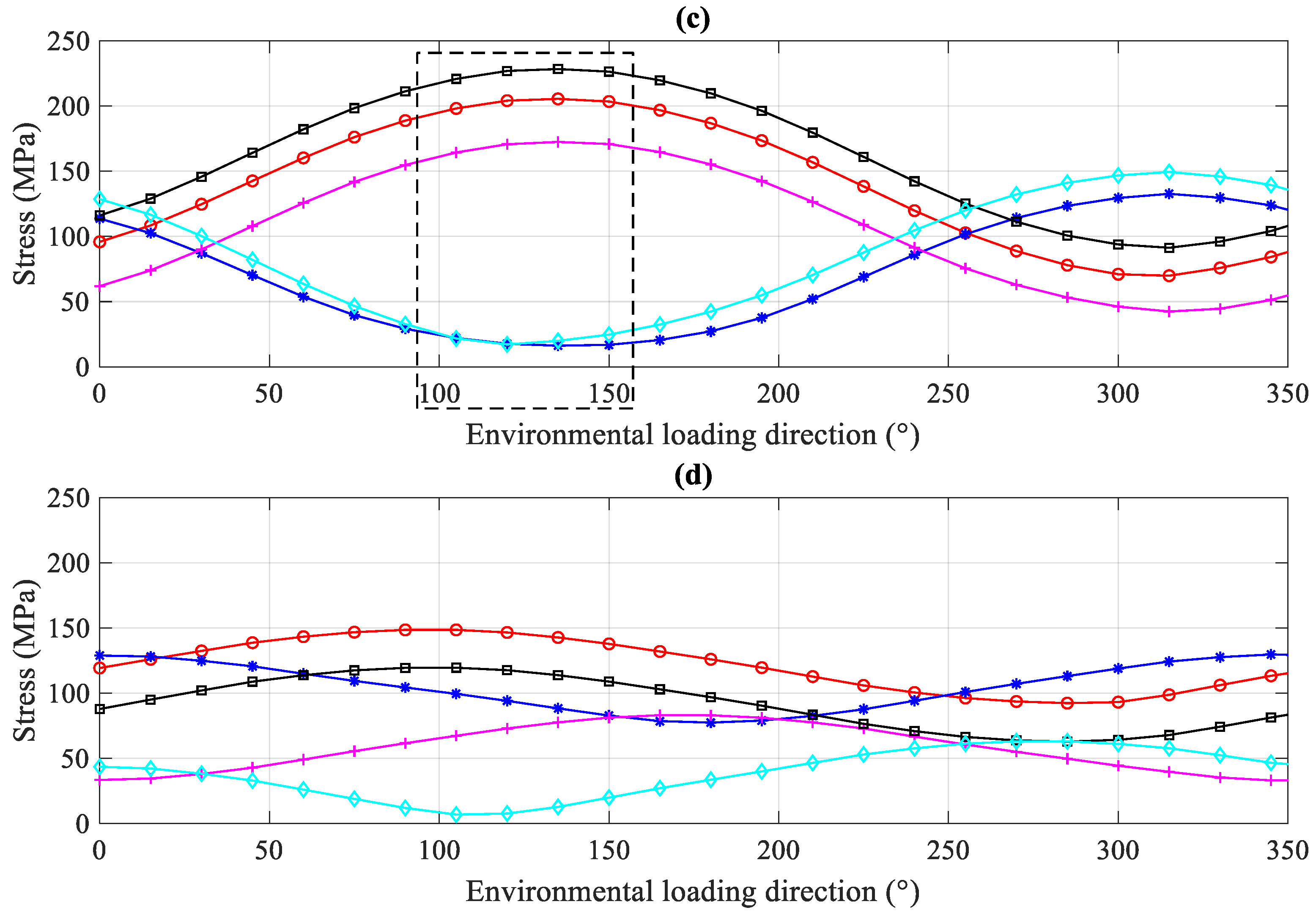

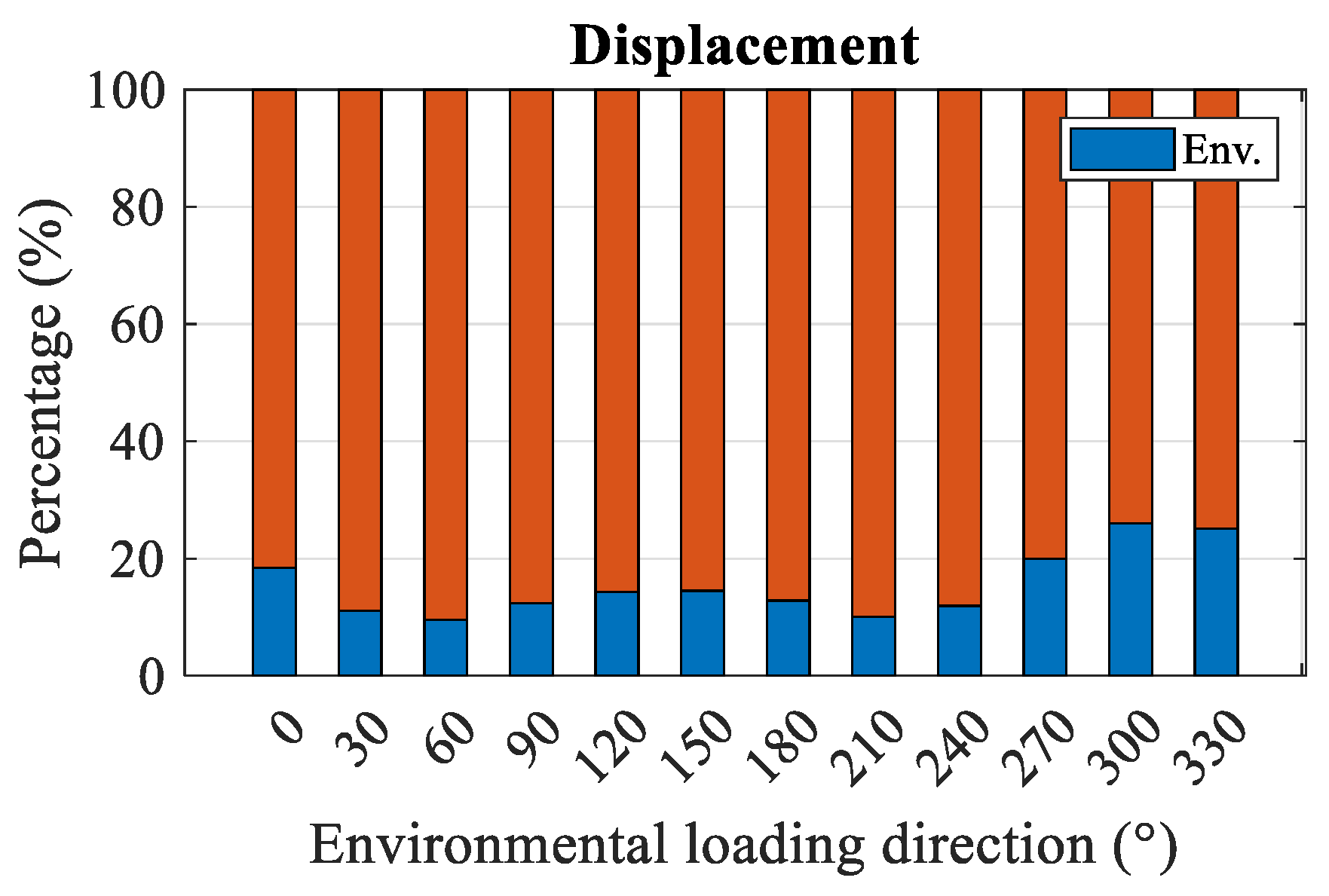
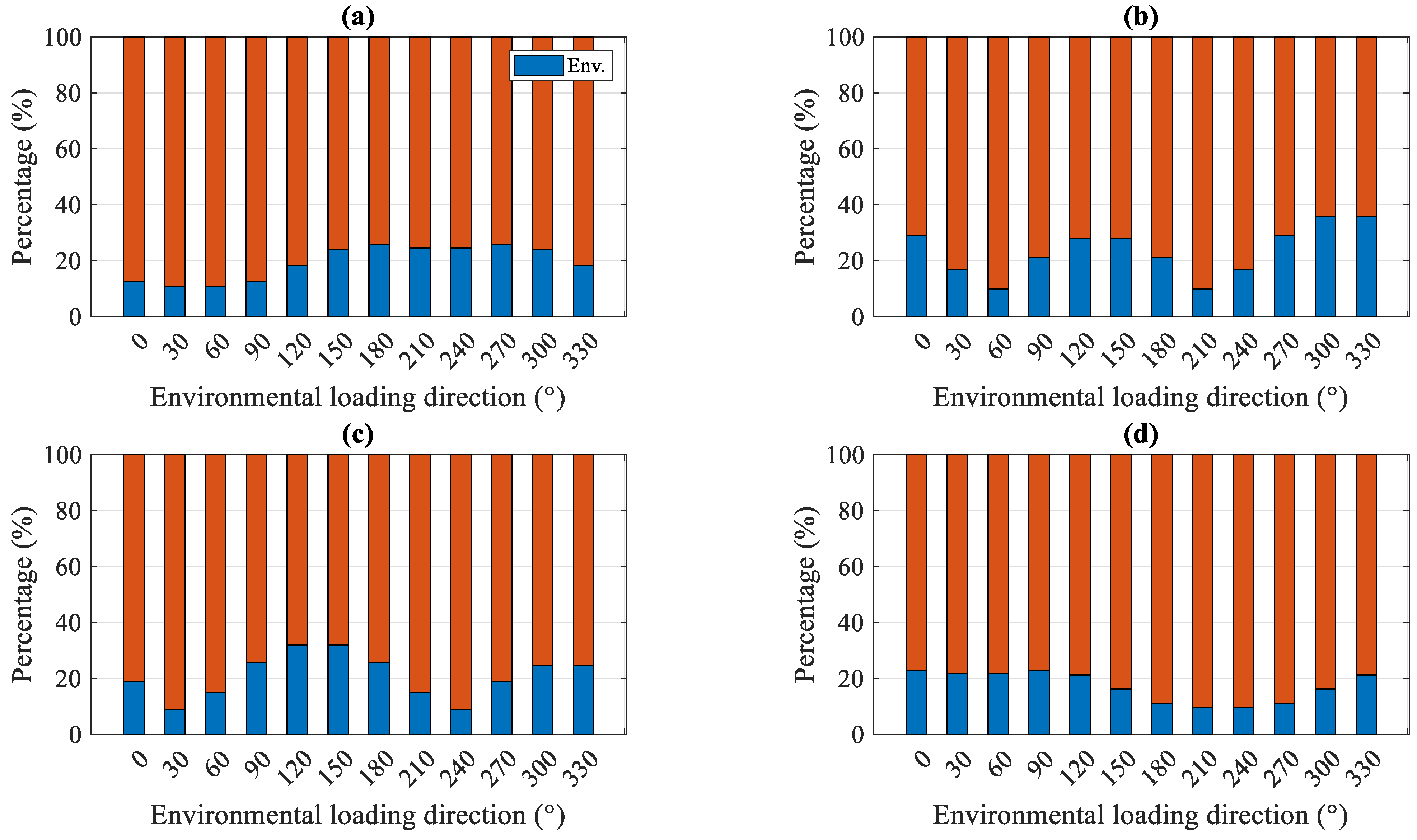
| Description | Symbol | Value | Unit |
|---|---|---|---|
| Rotor-Nacelle-Assembly (RNA) | |||
| Rating | 3MW | ||
| Rotor orientation | Upwind, 3 blades | ||
| Hub height above platform | 56.78 | m | |
| Mass of the rotor | 64.60 | ton | |
| Mass of the nacelle | 128.00 | ton | |
| Mass of the RNA | 192.60 | ton | |
| Tower | |||
| Bottom diameter | 450.00 | cm | |
| Bottom thickness | 3.40 | cm | |
| Top diameter | 307.00 | cm | |
| Top thickness | 1.80 | cm | |
| 4-Leg Jacket Substructure | |||
| Height | 32.47 | m | |
| Leg diameter | 104.70 | cm | |
| Leg thickness | 1.60 | cm | |
| Brace diameter | 50.80 | cm | |
| Brace thickness | 1.90 | cm | |
| Description | Symbol | Value | Unit |
|---|---|---|---|
| Wind | |||
| Wind speed in 50-year condition | 42.50 | m/s | |
| Current | |||
| Current velocity in 50-year condition | 1.04 | m/s | |
| Wave | |||
| Average water depth | 14.00 | m | |
| Significant wave height in 50-year condition | 5.97 | m | |
| Wave period in 50-year condition | 11.16 | s | |
| Parameter | Symbol | Value | Unit |
|---|---|---|---|
| Density | 7850 | ||
| Young’s modulus | 210,000 | MPa | |
| Yield strength | 355 | MPa | |
| Poisson’s ratio | 0.3 | - |
| DLC | Descriptions | Force (kN) | Moment (kNm) | |||||
|---|---|---|---|---|---|---|---|---|
| DLC1 | Max | −39.0 | −959.0 | −5208.0 | 49,041.0 | −2496.0 | 2173.0 | |
| DLC2 | Min | −114.0 | 923.0 | −5197.0 | −47,885.0 | −4998.0 | −1731.0 | |
| DLC3 | Max | 781.0 | 4.0 | −6424.0 | 2369.0 | 45,635.0 | 373.0 | |
| DLC4 | Min | −699.0 | 49.0 | −5168.0 | 1038.0 | −39,301.0 | −298.0 | |
| DLC5 | Max | 31.0 | −146.0 | −5244.0 | 6720.0 | 5034.0 | 5385.0 | |
| DLC6 | Min | −181.0 | 198.0 | −5063.0 | −10,207.0 | −9979.0 | −6124.0 | |
| DLC7 | Max | 1051.0 | 807.0 | −4705.0 | −23,378.0 | 8965.0 | −1222.0 | |
| DLC8 | Min | −978.0 | −653.0 | −4737.0 | −22,496.0 | 10,333.0 | −742.0 | |
| DLC9 | Max | −714.0 | 1384.0 | −4722.0 | −19,975.0 | −10,358.0 | −1072.0 | |
| DLC10 | Min | 392.0 | −1352.0 | −4739.0 | 11,407.0 | 1986.0 | 964.0 | |
| DLC11 | Max | 220.0 | 745.0 | −4600.0 | 4275.0 | 3995.0 | 885.0 | |
| DLC12 | Min | 639.0 | 23.0 | −7203.6 | 2282.0 | 37,895.0 | 866.0 | |
Publisher’s Note: MDPI stays neutral with regard to jurisdictional claims in published maps and institutional affiliations. |
© 2021 by the authors. Licensee MDPI, Basel, Switzerland. This article is an open access article distributed under the terms and conditions of the Creative Commons Attribution (CC BY) license (https://creativecommons.org/licenses/by/4.0/).
Share and Cite
Tran, T.-T.; Kang, S.; Lee, J.-H.; Lee, D. Directional Bending Performance of 4-Leg Jacket Substructure Supporting a 3MW Offshore Wind Turbine. Energies 2021, 14, 2725. https://doi.org/10.3390/en14092725
Tran T-T, Kang S, Lee J-H, Lee D. Directional Bending Performance of 4-Leg Jacket Substructure Supporting a 3MW Offshore Wind Turbine. Energies. 2021; 14(9):2725. https://doi.org/10.3390/en14092725
Chicago/Turabian StyleTran, Thanh-Tuan, Sangkyun Kang, Jang-Ho Lee, and Daeyong Lee. 2021. "Directional Bending Performance of 4-Leg Jacket Substructure Supporting a 3MW Offshore Wind Turbine" Energies 14, no. 9: 2725. https://doi.org/10.3390/en14092725
APA StyleTran, T.-T., Kang, S., Lee, J.-H., & Lee, D. (2021). Directional Bending Performance of 4-Leg Jacket Substructure Supporting a 3MW Offshore Wind Turbine. Energies, 14(9), 2725. https://doi.org/10.3390/en14092725








